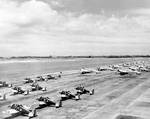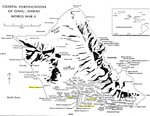Hickam Field
| Type | 13 Air Base | |
| Historical Name of Location | Honolulu, Oahu, Hawaii | |
| Coordinates | 21.335278000, -157.948333000 |
Contributor: David Stubblebine
ww2dbaseUnited States Army air operations in the Hawaiian area began in 1917 when the Army negotiated the purchase of Ford Island in Pearl Harbor's East Loch to be used jointly by the Army and the Navy to develop of military aviation in the Pacific. The Army established Luke Field on the northwestern half of the island and the Navy operated Naval Air Station Pearl Harbor on the other half (later, Naval Air Station Ford Island). The Army operated land-based aircraft from the island's interior (what had been sugar cane fields) and operated seaplanes from hangars and ramps at the waters edge.
ww2dbaseBy the 1930s, the Army's air program was moving in two directions at once: it was moving away from a seaplane air force and was developing a bomber force based on ever larger aircraft. Both factors caused Luke Field to become too small and obsolete for their needs so in 1935 the Army opened Hickam Field two miles away. Hickam Field is situated between the Naval Station and Fort Kamehameha on the southern shore and was adjacent to the existing civilian John Rodgers Airport (later Naval Air Station Honolulu and now Honolulu International Airport). With the opening of Hickam Field, the Naval Air Station expanded to fill all of Ford Island.
ww2dbaseHickam Field, along with Wheeler and Bellows Fields, were the Army's three primary air bases on Oahu. Hickam was designed from the beginning to have runways long enough for the largest bombers and its 7,000-foot runway was the only air strip on the island long enough for the B-17 Fortress and the B-24 Liberator.
ww2dbaseDuring the Japanese attack on Pearl Harbor of December 7, 1941, the Japanese strategy included plans to neutralize the American ability to interdict their aircraft or to pursue their fleet. For this reason, Wheeler, Bellows, and Hickam Fields were strafed and bombed, along with the Navy’s air facility at Kaneohe Bay. Hickam was the first hit and hardest hit. 139 were killed and 303 were wounded at Hickam Field alone, along with substantial damage to hangars and aircraft.
ww2dbaseWith the war, Hickam was home to squadrons of patrol planes patrolling the air above Hawaiian waters. It was also a critical "way station" for the heavy bomber aircraft being sent west to the war zones (heavy bombers and some medium bombers had to be flown to the war zones while light bombers and pursuit aircraft were ferried aboard ships). The base also played a major role in pilot training and aircraft assembly work. Hickam served as the hub of the Pacific aerial network, supporting transient aircraft ferrying troops and supplies to, and evacuating wounded from, the forward areas. Facilities at Hickam Field performed these functions not only in World War II but also during the Korean and Vietnam conflicts.
ww2dbaseWith the creation of the United States Air Force as a distinct service in 1947, Hickam Field became Hickam Air Force Base. Hickam remains very active and very important today, although in 2010 there was a change in the facility’s command structure. Hickam Air Force Base and the adjoining Pearl Harbor Naval Base were combined under a single command that is now called Joint Base Pearl Harbor-Hickam.
ww2dbaseSources:
Wikipedia
United States Air Force
Abandoned and Little Known Airfields
Hawaiian Aviation Archive
Last Major Update: Jan 2014
Hickam Field Interactive Map
Photographs
 |  |  |  |
Maps
 |  |
Hickam Field Timeline
| 6 Jan 2012 | The Captain Joseph J. Rochefort Building was dedicated at the National Security Adminstration facility in the Hickam Annex of Joint Base Pearl Harbor, Hawaii, United States. |
Please consider supporting us on Patreon. Even $1 per month will go a long way! Thank you. Please help us spread the word: Stay updated with WW2DB: |
Visitor Submitted Comments
19 Jan 2014 04:37:42 PM
Jim-
You are right, of course. Correction made.
19 May 2022 05:44:42 PM
I had a relative that died in the initial bombing. He was running to get in his plane as they were bombed. I think his last name was Yank, Wife Evelyn Yank California
All visitor submitted comments are opinions of those making the submissions and do not reflect views of WW2DB.

Honolulu, Oahu, Hawaii
Latitude-Longitude:
21.3353, -157.9483
- » 1,177 biographies
- » 337 events
- » 44,938 timeline entries
- » 1,245 ships
- » 350 aircraft models
- » 207 vehicle models
- » 376 weapon models
- » 123 historical documents
- » 261 facilities
- » 470 book reviews
- » 28,477 photos
- » 365 maps
General Douglas MacArthur at Leyte, 17 Oct 1944
Please consider supporting us on Patreon. Even $1 a month will go a long way. Thank you!
Or, please support us by purchasing some WW2DB merchandise at TeeSpring, Thank you!
19 Jan 2014 05:54:27 AM
Hickam was a "way station," not a "weigh station."